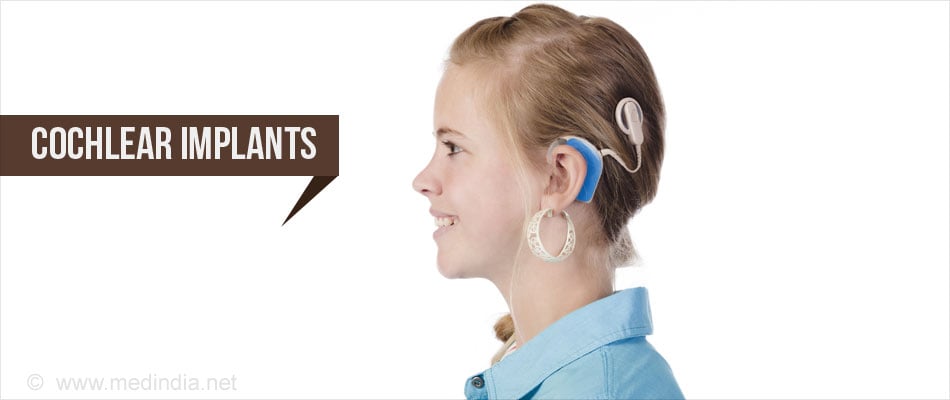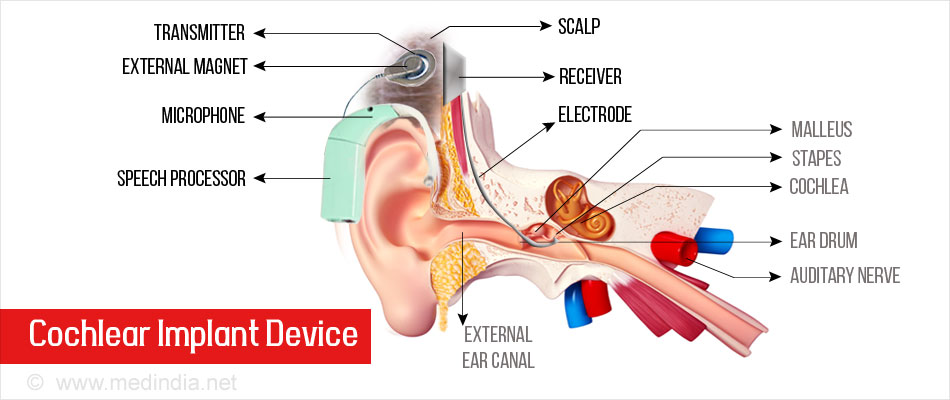- About Cochlear Implants - (https://www.nidcd.nih.gov/health/cochlear-implants)
- Information About Cochlear Implants - (http://www.asha.org/public/hearing/cochlear-implant/)
- Learn About Cochlear Implants - (http://kidshealth.org/en/parents/cochlear.html)
- Cochlear Implant Health - (http://www.entnet.org/content/cochlearimplants)
- Cochlear Implant - (https://en.wikipedia.org/wiki/cochlear_implant)
What are Cochlear Implants?
A cochlear implant, an electronic device that is surgically implanted to provide a sense of sound, helps a person who is severely hard of hearing to hear sounds. The device transmits external sounds and directly stimulates the receptor cells of the inner ear, inside the cochlea. Dr. William F.House amedical researcher invented the cochlear implant.
A cochlear implant is designed to send sound signals into the inner ear. It does not restore normal hearing for severely or profoundly hearing impaired persons. After the surgery is over, the person needs to undergo training to identify and understand the various sounds he or she hears with the help of the device.

There are more than 188,000 people in the world who have received cochlear implants. Ideally, cochlear implants are recommended for both ears. But an implant can also be fixed only for one ear as well.
What are the Parts of a Cochlear Implant?
The main parts of a cochlear implant are:
- Microphone – Picks up sounds from outside.
- Speech Processor – Filters the speech sounds from other environmental sounds. It is almost a mini-computer.
- Transmitter – Transmits sound signals from speech processor to the receiver / stimulator.
- Receiver / Stimulator – Converts the speech signals from the transmitter into electric impulses.
- Array of electrodes – A set of electrodes that receives impulses from the stimulator to send to different regions of the auditory nerve.
The microphone, speech processor and the transmitter are fitted externally over the ear. The receiver/stimulator is fitted just below the skin next to the transmitter. The electrode array is embedded in the cochlea.
How Does a Cochlear Implant Work?
During a normal hearing process, sound waves enter the ear and vibrate the eardrum. The vibrations are transmitted to the inner ear via three small bone, the malleus, incus and stapes. The vibrations that reach the inner ear ultimately stimulate sound sensitive receptor cells called the hair cells of the cochlea, the organ of hearing in the inner ear. The electrical signals thus generated travel through the auditory nerve, to the auditory area of the brain, where the sound is perceived.
Hearing via a cochlear implant is different from the normal hearing process. A cochlear implant is fitted to those candidates who have damaged hair cells of the cochlea but a normally functioning auditory nerve. The electrodes implanted in the cochlea do the job of stimulating the auditory nerve instead of the hair cells.

The cochlear implant works as follows:
- The microphone picks up the sound.
- The speech processor receives the sound.
- The speech processor analyzes the sound and converts it into electric signals. The transmitter on the skin sends these signals to the receiver-stimulator just under the skin.
- The receiver/stimulator receives the electrical signals from the transmitter and determines the amount of electric current that will be sent to the electrodes, which in turn determines the loudness of the sound.
- The position of electrodes in the cochlea determines the pitch of the sound.
Who can Undergo a Cochlear Implant Surgery?
A cochlear implant can be used by persons with sensorineural hearing loss, when the cochlea is damaged but the auditory nerve is intact.
Adults who can benefit from cochlear implants include those with:
- Severe to profound hearing loss in both the ears.
- Hearing impairment after having learned to communicate in spoken language.
- Inadequate amplification provided by hearing aids.
- No medical problems that may contraindicate a surgery.
Children who can benefit from cochlear implants include those with:
- Profound hearing loss in both the ears.
- Limited amplification provided by hearing aids.
- An age of one to five years.
- The absence of any intellectual or neurological disability.
- The possibility of benefitting from intensive auditory training and speech therapy programs.
Cochlear implants will not benefit those who have hearing loss due to nerve damage as the signals sent by the electrodes of the implant will not reach the brain.
How is a Candidate for Cochlear Implant Selected?
A battery of tests is performed for determining if a person is suitable and can benefit from cochlear implant surgery. These include
Audiologic Testing:
- Middle ear testing and inner ear functions
- Stapedial Reflex testing
- Auditory Brainstem Response
- Otoacoustic emission testing
- Audiometry or hearing test

Neurological Testing:
- Functioning of the auditory nerve
- CT or MRI scan to evaluate inner ear, facial nerve and vestibulocochlear nerve
- MRI for examining brain and brainstem
Psychological Testing:
- Aptitude testing – to determine if the candidate can undergo intensive post-operative training.
- Willingness to learn and adapt.
How is the Surgical Procedure for Cochlear Implant Performed?
A cochlear implant surgery is done under general anesthesia. The procedure may take about 2-4 hours.
Implant Package:
- The surgeon drills a 3 to 4 millimeter bed in the temporal bone, just behind the ear. The implant is placed here.
- The mastoid bone, the prominent bone behind the ear, is opened to access the middle ear.
- Through this opening, a small hole is drilled into the cochlea.
- Wires that contain electrodes are inserted into the cochlea.
- The whole package is then secured and sealed.
- A dressing is worn over the implant area for about a day.

External Device:
- About 2-4 weeks after surgery, the external device is fitted.
- This device containing the microphone and speech processor is placed behind the ear. The speech processor may also be kept in the pocket or at other locations on the body.
- The speech processor is programmed to match with the implant.
- The device is fine-tuned to suit the individual requirements.
What are the Features of Cochlear Implants?
Some features of cochlear implants include the following:
- Multichannel Stimulation: The cochlear implant system must have electrode arrays with multiple contacts to provide multichannel stimulation. This helps in better sound identification and discrimination.
- Transcutaneous Transmission: The external device communicates with the internal device via the transmitting coil. There are no wires that cross the skin barrier. Magnets fitted on both the devices to maintain the contact between the coils.
- No Battery in the Implant: The implant package draws power from the battery of the externally-worn hardware. The internal device does not have its own power source.
- Telemetry: Telemetry is a technology used in cochlear implants that monitors the integrity of the internal electrodes through the external system after they are implanted.
- Speech Processing Strategies: The speech processing device translates the pitch, timing and loudness information into electrical signals. These electrical signals are sent to the specific electrodes in a specific manner for the signals to reach the nerve. Different brands offer different speech processing strategies that can be chosen according to the requirement of the recipient.
- Cost Across Brands: The costs of the cochlear implant devices do not vary much across brands. Most brands offer warranties and service contracts.
- Features Across Brands: Most brands offer similar features of sound reception, transmission and electrode stimulation. However, different brands have individual features like bipolar stimulation, analog stimulation and differences in electrode arrays.
Using the Cochlear Implant
About 90 percent of adults who have received a cochlear implant are able to understand speech without the use of visual clues or lip reading. Many recipients have reported that using a regular telephone has been better since they have started using the implants.
Programming the device includes establishing the minimum and the maximum stimulation levels for each electrode that is fitted inside the cochlea. This is done via the speech processor, the external unit. These thresholds can be adjusted several times during the post-surgical follow-ups.
Fine tuning the functioning of the cochlear implant is a gradual process and may take several months. Along with the fine tuning, the recipient of the implant is also trained to identify sounds he or she hears via the implant and the electrodes. Mapping or fine-tuning the cochlear implant is an essential part of the post-surgical therapy and is done by trained audiologists.
Children who are born with hearing impairment and are fitted with cochlear implant will grow with the device. The sounds received via the electrodes will allow them to develop the brain pathways to hear the sounds. The children must undergo intensive auditory training and speech and language therapy for the next few years.
Speech and language therapy involve training the child to develop spoken language in terms of expression and comprehension. This is done through identifying, imitating and associating words, sentences and speech flow.

Training a child who has received a cochlear implant requires the involvement of parents and significant persons of the child’s life for the child to develop speech and language skills and get integrated into the mainstream schools.
What are the Risks of Cochlear Implant Surgery?
As with any other surgery, cochlear implant surgery also carries some risks. Some of the possible problems include:
- Risks of bleeding and infections of the surgical site.
- Dizziness or balance problems.
- Injury to the facial nerve that runs via the middle ear. This may cause weakness or paralysis of one side of the face.
- Injury to the nerve that carries sense of taste to the brain.
- Tinnitus (ringing in the ear)
- Malfunctioning of the device, which can require another surgery to replace the implant.
- Leakage of the cerebrospinal fluid surrounding the brain.
- Meningitis, which may be prevented by vaccination prior to the procedure.
Alternatives to Cochlear Implants
Cochlear implants are not suitable for all children and adults with profound hearing loss.
Alternatives to cochlear implants include:
- Assistive Devices
- Middle ear implants
- Auditory brainstem implants
- Bone anchored hearing aids
- Communication options - lip reading, cued speech, fingerspelling
Health Tips
- After surgery, prevent dampness at the surgical site to prevent infection.
- Even if the device is waterproof, avoid water entering the device.
- Consult your doctor in case of any discharge from ear or any ringing in the ear.
- Discuss and inform your audiologist if there is any change in hearing sounds after fine-tuning of the device.
- Take care of the external unit. Replace battery whenever required.










